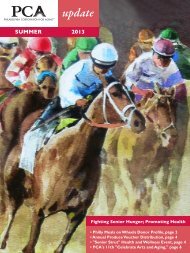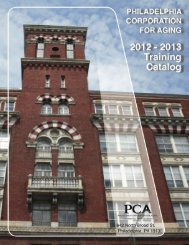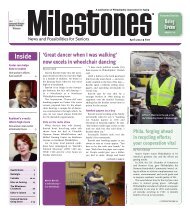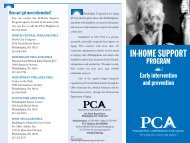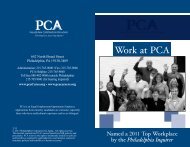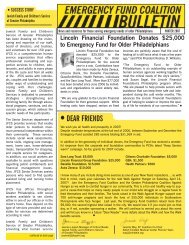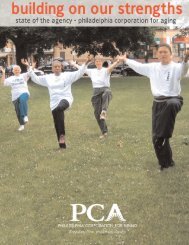A Guide to Housing Resources For the Elderly In Philadelphia
A Guide to Housing Resources For the Elderly In Philadelphia
A Guide to Housing Resources For the Elderly In Philadelphia
You also want an ePaper? Increase the reach of your titles
YUMPU automatically turns print PDFs into web optimized ePapers that Google loves.
DEFINITIONS OF TERMST T 1-13<br />
SECTION 8 EXISTING RENTAL ASSISTANCE<br />
A Federal program that provides rental assistance <strong>to</strong> low-income families who are unable <strong>to</strong> afford market rents.<br />
Assistance may be in <strong>the</strong> form of vouchers or certificates.<br />
SECTION 8 HOMEOWNERSHIP PROGRAM<br />
Allows low-income families who qualify for Section 8 rental assistance <strong>to</strong> use <strong>the</strong>ir certificates or vouchers <strong>to</strong> pay<br />
for homeownership costs under a mortgage.<br />
SKILLED NURSING FACILITY (SNF)<br />
A nursing facility that delivers skilled, intermediate, and cus<strong>to</strong>dial care. Registered nurses provide 24-hour nursing<br />
services that must be prescribed by a physician. These facilities are licensed by each state.<br />
SOCIAL SECURITY ACT OF 1935<br />
TITLE II - Federal Old-Age, Survivors, and Disability <strong>In</strong>surance Benefits (OASDI). Enacted in 1935, Social<br />
Security replaces a portion of earned income lost as a result of a person's retirement, disability, or death. Monthly<br />
benefits are paid as a matter of earned right <strong>to</strong> workers who gain insured status and <strong>to</strong> <strong>the</strong>ir eligible spouses, children,<br />
and survivors. Retirement benefits can begin at age 62 and are payable for life. Disability benefits are payable <strong>to</strong><br />
those insured workers who meet <strong>the</strong> act's definition of disability.<br />
TITLE XVI - Supplemental Security <strong>In</strong>come for <strong>the</strong> Aged, Blind, and Disabled (SSI). The SSI program was<br />
enacted as part of <strong>the</strong> 1971 Social Security amendments. It replaced <strong>the</strong> federal-state public assistance programs <strong>to</strong> <strong>the</strong><br />
aged, blind, and disabled, which <strong>the</strong> states had administered. The program is now federally administered and provides<br />
a supplemental public assistance payment <strong>to</strong> those who are eligible. States have <strong>the</strong> option of increasing <strong>the</strong> amount of<br />
<strong>the</strong> supplement at <strong>the</strong>ir expense. <strong>In</strong> many cases, SSI recipients are au<strong>to</strong>matically eligible for o<strong>the</strong>r forms of assistance<br />
such as Medicaid, food stamps, and social services.<br />
TITLE XVIII - Health <strong>In</strong>surance for <strong>the</strong> Aged and Disabled (Medicare). The Medicare program was enacted in<br />
1965, providing health insurance coverage for persons age 65 or older, some disabled persons under age 65, and<br />
persons who have end-stage renal disease. The program consists of three parts:<br />
• Part A, Hospital <strong>In</strong>surance (HI) provides basic protection against <strong>the</strong> costs of hospital and related post-hospital<br />
care, home health services, and hospice care<br />
• Part B, Supplemental Medical <strong>In</strong>surance (SMI is a voluntary program for which enrollees in Part A must pay<br />
80 percent of reasonable charges for medical and related health services and supplies furnished by physicians<br />
(or o<strong>the</strong>rs in connection with physicians' services). Generally, it does not pay for out-of-hospital prescription<br />
drugs, glasses, hearing aids, or immunizations.<br />
• Part D, Prescription Drug Coverage is a voluntary program in which enrollees pay a premium receive for<br />
prescription drug coverage. Coverage varies depending on <strong>the</strong> plans offered.<br />
The program is administered by <strong>the</strong> Centers for Medicare and Medicaid Services (CMS). See www.medicare.gov.<br />
TITLE XIX - Medical Assistance Program (Medicaid). This program also became law in 1965. It provides<br />
medical assistance for certain low-income individuals and families. It is financed jointly by state and federal funds<br />
and administered by <strong>the</strong> individual states within broad federal guidelines. Generally, all who qualify for public<br />
assistance under federally funded categories (aged, blind, disabled, and families with dependent children) are eligible<br />
for Medicaid. O<strong>the</strong>rs may qualify at a state's option. <strong>For</strong> <strong>the</strong> low-income elderly, Medicaid provides a particularly<br />
important provision, payment of nursing home care. All states except Arizona currently have Medicaid programs.<br />
Programs vary from state <strong>to</strong> state.



